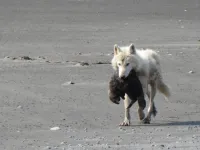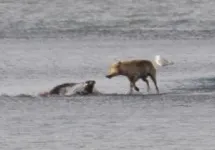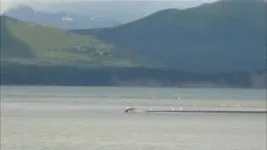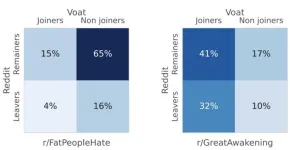(Press-News.org) CORVALLIS, Ore. – Firsthand observations of a wolf hunting and killing a harbor seal and a group of wolves hunting and consuming a sea otter on Alaska’s Katmai coast have led scientists to reconsider assumptions about wolf hunting behavior.
Wolves have previously been observed consuming sea otter carcasses, but how they obtain these and the frequency of scavenging versus hunting marine prey is largely unknown. Scientists at Oregon State University, the National Park Service and Alaska Department of Fish and Game are beginning to change that with a paper just published in Ecology.
In the paper, they describe several incidents they observed involving wolves and marine mammals in Katmai National Park that they believe haven’t been previously documented:
In 2016 the researchers witnessed a male wolf hunt and kill a harbor seal. The wolf was positioned near the mouth of a creek when it charged into the water, grabbing the tail of the harbor seal. The wolf continued to tear into the flesh of the seal’s tail and after an approximate 30-minute struggle, the seal appeared to tire, straining to lift its head above water. The wolf dragged the seal onto the exposed sandbar and began to tear into the existing wound and consume the tail.
On three separate days in 2016, 2018 and 2019 the scientists and others observed wolves carrying sea otter carcasses.
In 2021, the researchers watched three wolves hunt and eat an adult sea otter on an island during a low tide. They watched the wolves travel to the island, then lost sight of them for about one minute and then saw them reappear carrying a limp sea otter. They fed on the carcass for about 60 minutes. Once the wolves left, the researchers examined the kill site and found an area of concentrated blood where the sea otter was likely killed. The presence of blood indicates the sea otter had been alive when ambushed by the wolves, as opposed to being scavenged, the researchers note.
“This is really exciting documentation of behaviors we believe have never been directly observed by scientists,” said Ellen Dymit, a doctoral student at Oregon State. “It kind of forces us to reconsider the assumptions that underlie a lot of our management decisions and modeling around wolf populations and populations of their prey, which often assume that wolves depend on ungulates, like moose and elk.”
The research project originated in 2016 when Kelsey Griffin, a National Park Service biologist, and some of her colleagues stopped for lunch on the beach during a day of conducting marine debris and bird mortality surveys at Katmai National Park.
“Seemingly out of nowhere, we are sitting there, we just see this white wolf carrying an otter just trotting by,” Griffin said. “What? I was just blown away. I have never seen anything like that before.
“Then I was asking my co-workers: ‘Has anyone seen this before? Do wolves often eat sea otters?’ I was just asking a bunch of questions about the wolves and it just seemed like there was not a whole lot of information about them. That was the initial observation. I just got lucky. Wolves on the Katmai coast have never been studied and our research highlights the unique role wolves play in nearshore ecosystems in Alaska”
Griffin connected with Gretchen Roffler, a biologist with Alaska Department of Fish and Game, who introduced Griffin to Taal Levi, a professor at Oregon State and Dymit’s advisor.
The project builds on work by Roffler, Levi and others on wolves and sea otters on Pleasant Island, an island landscape adjacent to Glacier Bay about 40 miles west of Juneau and hundreds of miles east of Katmai across the Gulf of Alaska.
In a paper published earlier this year, they found wolves on Pleasant Island caused a deer population to plummet and switched to primarily eating sea otters in just a few years. They believe this is the first case of sea otters becoming the primary food source for a land-based predator.
Future papers will include analysis of wolves and sea otters from Lake Clark National Park, Glacier Bay National Park and Kenai Fjords National Park, in addition to Katmai. The research team plans to look at how sea otter density impacts the diets of wolves and variations of wolf diet on a pack level versus and individual level.
Dymit, Griffin and Roffler are all authors of the paper. Dymit and Levi are in the Department of Fisheries, Wildlife, and Conservation Sciences in Oregon State’s College of Agricultural Sciences. Griffin is director of the Ocean Alaska Science and Learning Center in Seward, Alaska. Roffler is based in Douglas, Alaska.
END
Researchers observe wolves hunting and killing sea otters and harbor seals on Alaska’s Katmai coast
2023-10-31
ELSE PRESS RELEASES FROM THIS DATE:
Pilot awards to advance global brain health and dementia projects
2023-10-31
Today, the Alzheimer’s Association, Global Brain Health Institute (GBHI), and the UK-based Alzheimer’s Society announced the most recent awardees of the Pilot Awards for Global Brain Health Leaders, a competitive funding initiative dedicated to nurturing efforts and improving outcomes in the fields of brain health and dementia.
“The Alzheimer’s Association is proud to partner with GBHI and the Alzheimer’s Society to make these innovative grants,” said Heather M. Snyder, Ph.D., Alzheimer’s Association vice president of medical and ...
Anesthesia technology precisely controls unconsciousness in animal tests
2023-10-31
If anesthesiologists had a rigorous means to manage dosing, they could deliver less medicine, maintaining exactly the right depth of unconsciousness while reducing postoperative cognitive side effects in vulnerable groups like the elderly. But with myriad responsibilities for keeping anesthetized patients alive and stable, as well as maintaining their profoundly unconscious state, anesthesiologists don’t have the time without the technology.
To solve the problem, researchers at The Picower Institute for Learning and Memory ...
The limits of deplatforming
2023-10-31
Social media can incubate communities that are so resilient that even banning them from the platform cannot destroy them. Michele Starnini and colleagues studied two online communities on the social media site Reddit: the far-right conspiracy theory subreddit GreatAwakening, which was banned in 2018, and the hate-speech subreddit FatPeopleHate, banned in 2015. Both communities decided amongst themselves to move to Voat, an unmoderated Reddit clone designed to serve those banned by Reddit. The authors estimate that less than 20% of FatPeopleHate users migrated to Voat, while more than 70% of GreatAwakening users migrated to the new platform. This result suggests that members ...
CCDC expands global talent pool with Ghana-based Orgmento
2023-10-31
· CCDC extends its partnership with Orgmento, a Ghanaian software engineering and data sciences company.
· The partnership, which started in 2021, has been strengthened by the shared commitment to engineering excellence from both organizations, and has now been extended for a further 3 years.
· Software engineering teams from the CCDC and Orgmento will build software to advance structural science.
Cambridge, UK. 31 October 2023
The Cambridge Crystallographic ...
DNA organization influences the growth of deadly brain tumors in response to neuronal signals
2023-10-31
A pioneering study at Umeå University, Sweden, has unveiled that the 3D organization of DNA can influence the progression of the aggressive brain tumour known as glioblastoma. Having identified the factors that glioblastoma uses to respond to neurons by growing and spreading, this discovery paves the way for further research into new treatments for brain tumours.
"We have now identified the most important factors behind how the tumour responds to nerve cells, thus becoming more dangerous. These findings offer hope in our long-term battle against this difficult-to-treat ...
Humans are disrupting natural ‘salt cycle’ on a global scale, new study shows
2023-10-31
The planet’s demand for salt comes at a cost to the environment and human health, according to a new scientific review led by University of Maryland Geology Professor Sujay Kaushal. Published in the journal Nature Reviews Earth & Environment, the paper revealed that human activities are making Earth’s air, soil and freshwater saltier, which could pose an “existential threat” if current trends continue.
Geologic and hydrologic processes bring salts to Earth’s surface over time, but human activities such as mining and land development are rapidly accelerating the natural “salt ...
Want to prevent misinformation? Present data with an interactive visual.
2023-10-31
Getting readers of a news story interested in numbers can be a challenge. But the benefits of engaging readers in data can lead to a better understanding, preventing misinformation and misrepresentation in the news.
New research by Haiyan Jia, assistant professor in the Department of Journalism and Communication and the Data X Initiative at Lehigh University, and S. Shyam Sundar, the James P. Jimirro Professor of Media Effects at Penn State University, explored different ways journalists present data and recommend a method using an interactive visualization.
Inspired by exemplification theory, Jia wanted to see the persuasive effect data could have and whether ...
Surrey researchers use AI to make mobile networks more efficient
2023-10-31
A new artificial intelligence (AI) model, developed by the University of Surrey, could help the UK's telecommunications network save up to 76% in network resources compared to the market's most robust Open Radio Access Network (O-RAN) system – and improve the environmental sustainability of mobile networks by using less energy.
In a study published in the journal IEEE Transactions on Network Service Management, Surrey researchers detail how it is possible to save bandwidth by mathematically modelling the network and using AI to find the best ...
Giant planets cast a deadly pall
2023-10-31
Giant gas planets can be agents of chaos, ensuring nothing lives on their Earth-like neighbors around other stars. New studies show, in some planetary systems, the giants tend to kick smaller planets out of orbit and wreak havoc on their climates.
Jupiter, by far the biggest planet in our solar system, plays an important protective role. Its enormous gravitational field deflects comets and asteroids that might otherwise hit Earth, helping create a stable environment for life. However, giant planets elsewhere in the universe do not necessarily protect life on their smaller, rocky planet neighbors.
A new Astronomical Journal paper details how the pull of massive ...
GED recipients have worse health outcomes than high school graduates
2023-10-31
Toronto, ON — New research published earlier this month in the International Journal of Aging and Human Development has highlighted the significant health disparities among older adults with a General Education Development (GED) certificate compared to their peers with a high school diploma.
Researchers from the University of Toronto examined health outcomes among approximately 400,000 older adults from the American Community Survey, a representative sample of community-dwelling and institutionalized older Americans. They found that ...







